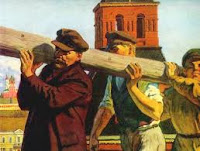Before you open the mouth do the Math
“My great-great-great-many-times-removed grandfather
was on the ‘Mayflower’.” I’ve heard so many times wonderful stories about many-times-removed
great uncles, grandmothers and siblings that came by “Mayflower” from so many
people I met here that one day I got curious how many passengers could the
Mayflower take aboard?
Between 1620 and 1630 a vessel
named "Mayflower" crossed the seas three times. One in 1620 carried
the Pilgrim Fathers to New Plymouth; one in 1629 carried the Higginson party to
Salem; and one in 1630 carried the Winthrop party to Charlestown. It has
generally been assumed that these three voyages were made by the same ship. William Bradford says that “the strong probability is that the voyages of 1629 and 1630
were not made by the ship that sailed in 1620." Bradford says of the
Mayflower company: "These being about a hundred souls, came over in the
first ship." Afterwards he adds: "Of these one hundred persons who
came over in this first ship together, the greatest half died in the general
mortality, and most of them in two or three months' time." So the exact
number seems like 50 passengers who made it on the Mayflower.
I can’t help but compare
the growing number of Mayflower passengers with the number of volunteers
helping Vladimir Lenin to carry a heavy log at the First Bolshevik Free Labor
spring event that took place on Saturday – Sabbath, which is Subbota in Russian.
The event became known as “Subbotnik” and was designed to set a heroic example
of true communist free labor. The picture in our school books depicted the balding
grandfather of communism with several people behind him. Many times during
school meetings we hosted speakers who shared their memories of carrying the
log elbow to elbow with Lenin himself. We kids sat with our mouths wide open:
these people saw Lenin.
Another historic event
tempted even more – the murder of the last Tsar of Russia Nicolas II. The
prideful chain of murderers bragged about the brightest moment of their life to
children in every school without any shame. Shaking their revolvers above their
heads, men and even women boasted. “We took the Tsar and his wife Alexandra,
their children, servants including the doctor and the cook downstairs and
pronounced the verdict of the Bolshevik Government. Justice prevailed: we
couldn’t wait to start shooting. The daughters had their family’s jewelry wrapped
around their bodies under their nightgowns, so we didn’t kill them with the
first volley. The girls were screaming and running along the wall, trying to
hide. We had to continue shooting until it was all over.” Later we started getting the children of
those heroes with the stories of their fathers and mothers. The legends
continued growing as well as the number of participants.
If we truly placed all
those people claimed by the descendants on the Mayflower, linked them to the
log and into the basement of the house where the Tsar was killed, the ship
would sink, the log would be hundreds and hundreds miles long, and the basement
will be of the size of the city.
We all can get enthused
as children when we witness something exciting and then we share with our
children, and they, in their turn, want to share it with their kids what their
parents witnessed. We all want to belong to great names or relate to great
events but why can’t we sometimes simply do the math first.




Comments